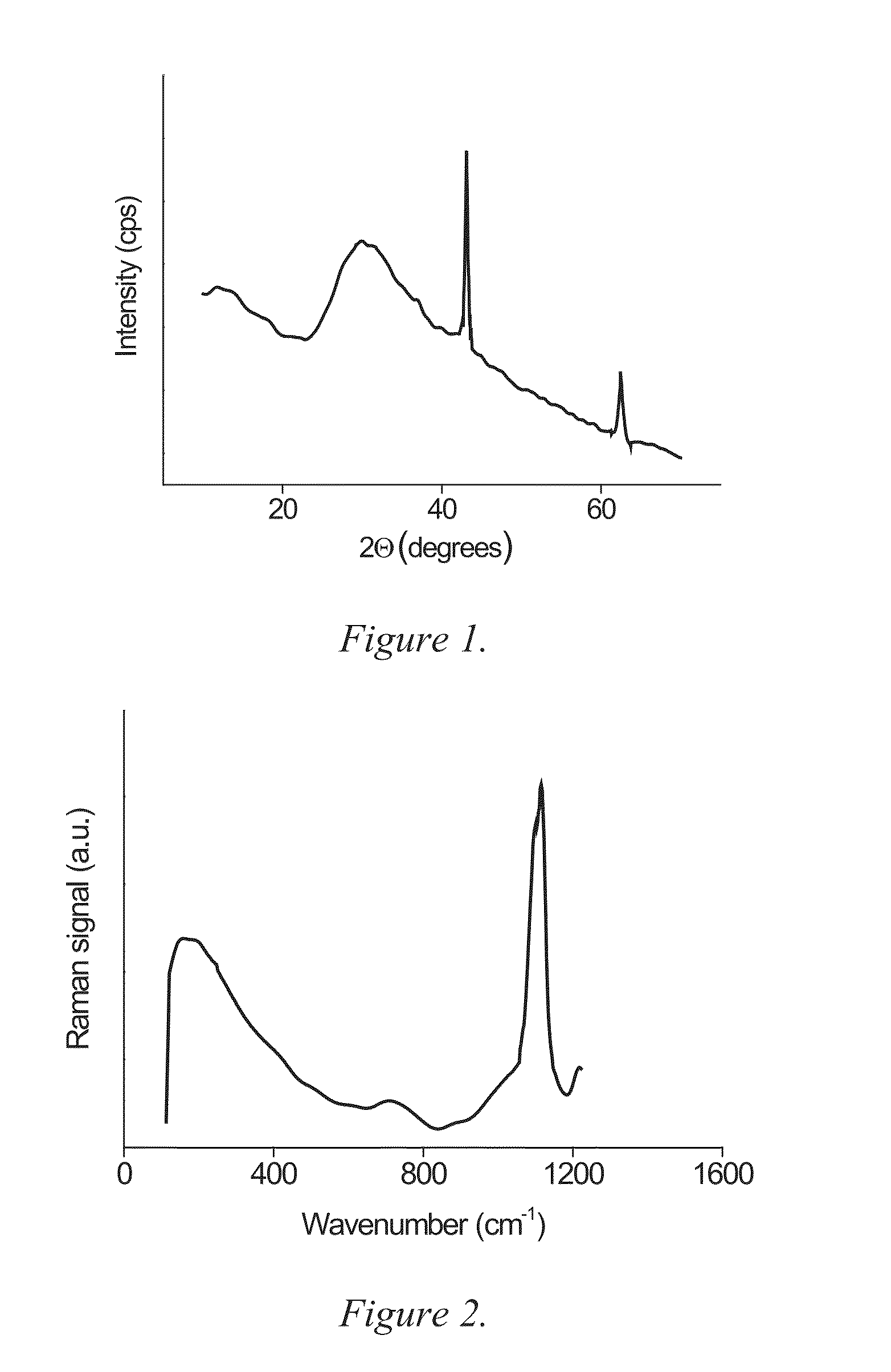Anhydrous, amorphous and porous magnesium carbonates and methods of production thereof
- Summary
- Abstract
- Description
- Claims
- Application Information
AI Technical Summary
Benefits of technology
Problems solved by technology
Method used
Image
Examples
specific example
[0177]In a preferred embodiment of the invention MgO is used as the Mg-precursor and methanol (CH3OH) as the alcohol and the steps of the method comprise:
[Step 1]Mixing a Mg-containing precursor and an alcohol-containing liquid:MgO (e.g. 4 g) and methanol (CH3OH) (e.g. 60 ml) are mixed, the suspension isheated to between 50° C. and 70° C. for 3-4 hours to form the intermediateMg(OH)(OCH3), most preferably to 50° C. The solution is continuously stirredduring this step.[Step 2]Reacting the mixture with CO2:The solution, now containing Mg(OH)(OCH3), is pressurized with 1-3 bar aboveatmospheric pressure CO2 to form the intermediate Mg(OCO)(OCH3)2 and / orMg(OCO)(OCH3)(OH),. The CO2 pressure can be applied during step 1 as well,i.e. when MgO and methanol is mixed. At this point the temperature is betweenroom temperature (i.e. 25° C.) and up to about 55° C. The solution is continuouslystirred during this step. Higher temperatures decreases the solubility of CO2 in theliquid, which is negati...
example 1
[0194]The dried material formed a coarse powder that was primarily amorphous with traces of unreacted and crystalline MgO, see X-Ray Diffraction (XRD) pattern in FIG. 1. The sharp peaks at 43° and 62° 2θ originate from the unreacted MgO while the halo peak between 25° and 40° 2θ is indicative of at least one amorphous phase.
[0195]Raman spectroscopy reveals that the powder is indeed composed of magnesium carbonate, see FIG. 2, where the band at ˜1100 cm−1 corresponds to vibration of the carbonate group. Moreover, a broad halo, or the so-called Boson peak, with a maximum at ˜100 cm−1 further witnesses of the amorphous character of the powder.
[0196]When examined with Fourier transform infrared spectroscopy (FTIR), see FIG. 10, the material shows absorption bands at ˜1440 cm−1, ˜1100 cm−1 and ˜850 cm−1 which all correspond to the carbonate group. No water of crystallization is visible in this spectrum.
[0197]The anhydrous character of the bulk material is further confirmed by Thermal Gra...
example 2
[0207]As described in Example 1 but where the obtained powder was heat-treated at 70° C. for 7 days. The particles proved to be composed of a material similar to the one in Example 1, viz. amorphous and anhydrous magnesium carbonate with traces of MgO. However, the specific surface area proved to be 454 m2 / g, with a distinct pore size distribution around 6 nm. As can be seen in FIG. 14 the cumulative pore volume of pores with a diameter smaller than 10 nm is above 0.7 cm3 / g. The nitrogen sorption isotherm and the pore size distribution obtained via DFT analysis of the nitrogen isotherm for this sample is displayed in FIGS. 13 and 14, respectively. This well-defined pore size distribution is similar to those found in ordered mesoporous silica materials and seldom found elsewhere. Also this material was associated with a H2O vapor sorption isotherm similar to the one described in Example 1.
PUM
| Property | Measurement | Unit |
|---|---|---|
| Temperature | aaaaa | aaaaa |
| Temperature | aaaaa | aaaaa |
| Temperature | aaaaa | aaaaa |
Abstract
Description
Claims
Application Information
 Login to View More
Login to View More - R&D
- Intellectual Property
- Life Sciences
- Materials
- Tech Scout
- Unparalleled Data Quality
- Higher Quality Content
- 60% Fewer Hallucinations
Browse by: Latest US Patents, China's latest patents, Technical Efficacy Thesaurus, Application Domain, Technology Topic, Popular Technical Reports.
© 2025 PatSnap. All rights reserved.Legal|Privacy policy|Modern Slavery Act Transparency Statement|Sitemap|About US| Contact US: help@patsnap.com



